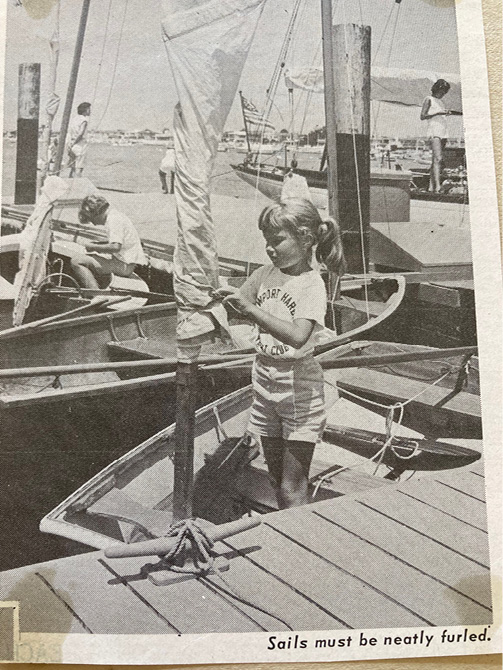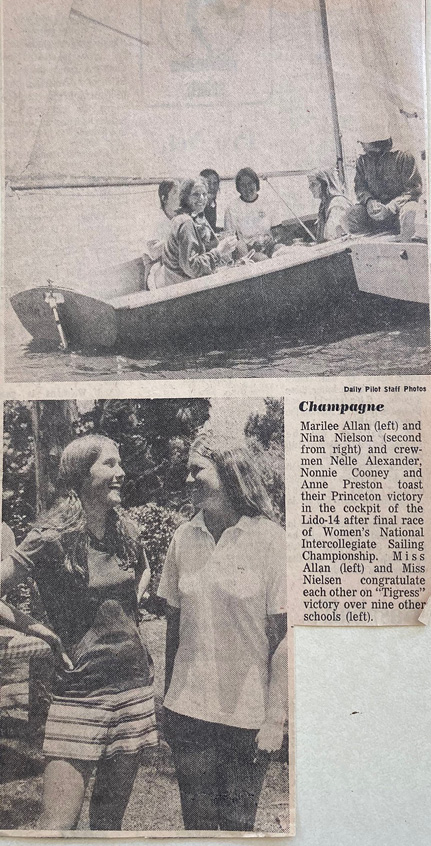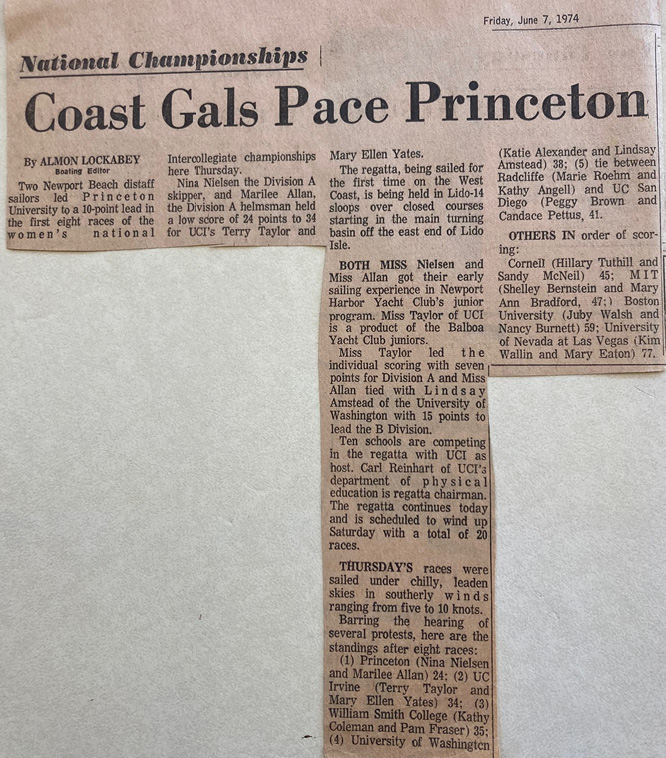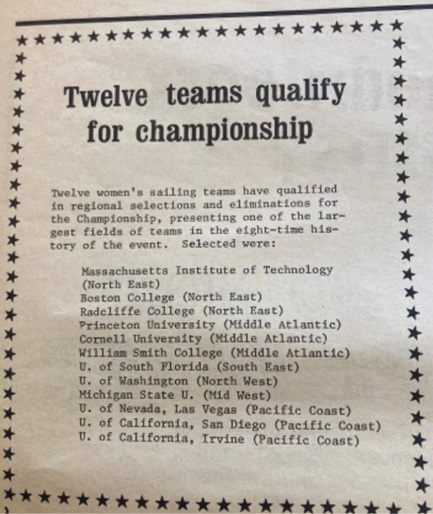Reliving the Past in Intercollegiate Sailing

Future Collegiate Hall of Famer Marilee Allan demonstrates proper seamanship, 1961
We learned in the recent streaming series on the New England Patriots, “The Dynasty,” that a true dynasty team needed to have at least three successive championships in four attempts to be described with the D-word. The 1960s Boston Celtics, the ‘80s LA Lakers, and ‘90s Chicago Bulls come to mind.
In the mid-1970s, in the very early days of Women’s intercollegiate sailing, one team made that grade and went one better. The Princeton Women’s Sailing Team kicked it off with a win in the National Women’s Intercollegiate Championship in 1974. That Tiger team ran off a “Four-peat” in June 1977 at the Women’s Nationals, a regatta I was lucky enough to coach.
I am passionate about the oral and documented history of sailing, known and little known. In the case of college sailing, fifty years back Women’s Sailing was new and little known, the first Nationals having been held in 1967. By 1974 two teams, Radcliffe and MIT had won five of the six events.
I went to the sailor who started the Princeton streak, my classmate Marilee Allan, Class of 1975. Marilee was among the 200 women who started Princeton in 1971 as freshmen. She lived on an all-female floor of a coed dorm. Coeducation was underway. It was a new world.
We told Marilee’s story in the November-December 2023 WindCheck, a piece that explored Princeton’s formative role in establishing college sailing, exemplified in the character of one Arthur Knapp, Class of 1928. Writing articles from imperfect memory and a few clippings can be challenging. Search engines, bless their AI hearts, can be useful and they can be misleading. We were thrilled when Marilee arrived with her own files.
Half a Century
The history of intercollegiate sailing tracked the late 19th century development of sailing as a sport. Yale claims it had the first college sailing club, established in Branford, CT in 1881, three years before the founding of the Oxford University Yacht Club in 1884. Harvard and Brown followed in 1894 and ‘96.
But behind the scenes, a handful of individuals thought it was time to put sailing on par with the biggest college game, namely football. Ironic isn’t it that the co-inventor of college football, Princeton, would also be the pioneer in intercollegiate sailing?
The landlocked school claims primacy for the first organized intercollegiate fleet racing in 1928 between a few schools in 8- Metres, for the Oliver-Hay Trophy. That keelboat regatta is known today as the McMillan Cup. The person behind this movement was Arthur Knapp, who grew up at Larchmont YC and comes across in his extensive writings as part Tony Robbins, part Elon Musk, and part Cicero.

The Lady Tigers toast their 1974 national championship (top photo), and Marilee Allan (left) and Nina Nielsen congratulate one another.
It was through another fellow Princetonian, Dick Rose, “Mr. Rules of Racing,” and most recently winner of the Beppe Croce Prize for worldwide contribution to the sport of sailing, that I learned that Knapp’s archives had been donated. In fact, so was the entire paper trail of intercollegiate sailing, going back to the 1930 establishment of the Intercollegiate Yacht Racing Association.
The impetus for this article started with this discovery that a large collection of ephemera, papers, articles and notebooks related to the early days of college sailing had been seconded to the archivist of the Mystic Seaport Museum. This is familiar turf for me, as I’ve dug through boxes in the MSM archives for articles on Alerion, the Boston Whaler, and frostbite dinghies. Alas, these new acquisitions were yet to be, in curatorial terms, “processed.” I was on my own to unveil the modern history of Women’s Collegiate Sailing. Fortunately, I had help.
The Allan Family Archives
Marilee Allan, Princeton ‘75, was the the baby sister following a string of water-crazy Allan brothers. It was Skip, fresh out of Stanford, in 1967, who skippered the family Cal 40 Holiday Too to a Transpac win along with brother Scott, a USC grad. In 1972, Scott blazed his own path – to the Olympics in the Flying Dutchman before becoming a fixture of Chesapeake Bay sailing. Marilee’s other brother was a surfer but not really a sailor. It all had started with their father, Robert Allan, who in 1940 at Stanford had helped start the Pacific Coast Intercollegiate Yacht Racing Association.
Thanks to Marilee’s mother, who dutifully kept the yellowed clippings on her kids’ results all those years, we were able to reconstruct the details of the Princeton Women’s Sailing Team’s 1974 inaugural win in Marilee’s homeport of Newport Beach, CA. Now a retired lawyer in Berkeley, Marilee, could spin the whole story of the 1974 campaign.
The competition was stiff. The Radcliffe team, coached by the veteran Mike Horn, had become accustomed to walking away with the Nationals trophy. They came into 1974 having won the Women’s National four of the prior six years, but the most intimidating opponent in 1974 was seen to be MIT, the ’73 champs. There it was: the matchup between the school of Oppenheimer and Einstein vs the MIT Lady Beavers.
Princeton’s 1974 A Division skipper was Nina Nielsen ‘76, who went on to be dentist in her hometown and a top echelon Etchells sailor. Nina was one of the most dominant college female skippers of her time, and she had a crew platoon of Anne Preston ’77 and Nelle Alexander ’76. Marilee Allan ‘75 and Nonnie (Alice) Cooney ’76 were the B Division team.
The headline in the local paper on Friday, June 7, 1974 captured the color and the scores of the event after 8 races: “Coast Gals Pace Princeton” (Imagine that headline today.?)
The cover of the event program showed a sparkling, smooth Pacific Coast waterscape.
The newspaper article continued: “Two Newport Beach distaff sailors led Princeton University to a 10-point lead in the first eight races of the Women’s National Intercollegiate Championship.
The regatta, being sailed for the first time on the West Coast, is being held in Lido-14 sloops over closed courses starting in the main turning basin off the east end of Lido Island.” They would sail twelve more races and Princeton would win handily.
Despite the win, there was no All-American status conferred to the Princeton skippers, Allan and Nielsen. The athletic director of Princeton and the college authorities would not endorse it. It would take to the mid-1990s for Marilee Allan and the late Nina Nielsen (whom we lost tragically in her 50s) to be inducted into the Intercollegiate Hall of Fame…probably the only inductees at that time who had not been named as “All-Americans.”
1977: The Four-Peat
By 1977, with the growth of coeducation at many schools, the talent pool for college sailing had grown exponentially. There were more and more skilled women skippers. No problem, led by Nina Nielsen, the Princeton Women won in Chicago in 1975 with Anne Preston, a product of the Noroton Yacht club’s racing scene, filling in for Marilee Allan. And it was repeated in 1976. Dynasty achieved!
The 1977 Princeton lineup was led by Anne Preston, now a three-time winner. In the B slot, it was Dorothy Bedford ’78, another Long Island Sound product, along with the strong crew platoon of Lucy Sutphen ’79 from New York City and Caroline Penfield’ 78 from New York’s Finger Lakes region.
Lucy was our reporter on the 1977 event. She had learned sailing in Sag Harbor, 100 miles east from her home on the Upper East Side of Manhattan. She had a family history that went back to whaling captains. Salt water was no stranger. Her father made a habit of going to sea as an observer on cargo ships, often on long voyages. In a long email to me, Lucy recounted the details of May 1977 with precision of the physician that she eventually became in Seattle, WA.
As for me, I was the pro tem coach, counselor and boat bailer for this regatta, held on the East River between the Bronx spit called Throggs Neck and Bayside, Queens. The river is wide as it sweeps out towards Kings Point and the Sound. The current is wickedly strong and the commercial ship traffic aggressive. To say this venue lacked traditional sailing charm was a massive understatement. The regatta center was the New York Maritime Academy, a state college for the sea teaching young me the practical skills of being a modern seaman. (Gary Jobson is perhaps Maritime’s best known modern graduate).
The racecourse inspired its own urban legends of floating bodies headed south from disposal in the Bronx. (I never hit one, but I talked with people who did!). Given all this, Lucy was kind but accurate when she said, “We were so grateful to have you there to coach and support us!” Anyone in their right mind, sailing on this intimidating, hostile piece of water would say that.
Lucy spoke about Anne with some awe: “Anne was the glue and the inspiration. So petite (Anne was perhaps 5’3”, no way she topped 100 pounds), yet so strong and determined. There was a rumor, likely true, that she used to work out in the weight room at Princeton and people walking by would shake their water bottles over her, to mimic being on the boat. I can certainly picture it in my mind even though I wasn’t there.”
Lucy crewed for the B skipper who was so nervous when she realized that every B team first place counted just as much as every A team win (which were going mainly to Preston). “Dorothy didn’t have the years of experience that Annie had, but she stuck with it.
For all of us, we hadn’t sailed together much. There were virtually no women’s races then. And we often couldn’t field a team when there was a Women’s regatta, especially if it fell on a weekend with a coed regatta. It took Dorothy and me a while to be in sync, and I don’t think we ever got to the level of knowing what the other person was thinking the way Anne and Nelle did.”
Not the World Series, not the NBA Finals perhaps, but it was a real dogfight out there in the East River. Lucy recalls, “I remember feeling the pressure to win and extend the streak of National titles to four and the desire not to ruin Anne and Nelle’s record. In many ways I had a mix of emotions, a weight of responsibility, a sense that I didn’t belong with such legends, and I was grateful to be along for the ride. We were lucky.”
Lucy still had the paper copy of the Sports Illustrated article on the 1977 win. In the “Vault” section of the publication, the most detailed article on the Women’s Intercollegiate Sailing regatta, was the headline penned by writer Julia Lamb: “Not yet ready to burn their bridges”

This report in a Newport Beach newspaper recounts the first day’s action.
The article continued, “In a short span, coeds have won acceptance on sailing varsities. But until they are as skilled as men, women find their own regatta a dandy test, especially when it is held in New York City’s turbulent waters. The traffic plying New York City’s crowded East River was even worse last week, being snarled by a fleet of racing dinghies manned by the best women sailors from 16 US and Canadian colleges. In the murky water off the Bronx, home port of host NY Maritime, they battled for the top awards in the 11th annual Women’s Intercollegiate Championships while trying to avoid collisions with tugs, destroyers, yachts, fishing boats and each other.”
“In small boat racing, women can compete on an equal footing with men. Two of the skippers in the intercollegiate, Allison Jolly of Florida State and Anne Preston of Princeton, have proved that.”
Allison had been selected as Yachtswoman of the Year in 1976. (She would go on to win Olympic Gold in 1988 in the 470 Class, the first year of Women’s Olympic Sailing competition.)
Anne was considered the finest sailor of either sex at Princeton and one of the top ten in the country. She had won the B Division skipper award for two straight years at the Intercollegiate. Now she was moving up to A to do battle with Allison Jolly.
The Sports Illustrated account echoed the daunting nature of the venue: “The triangular course for the 32 races lay between the mighty Throggs Neck and Whitestone Bridges, where the East River flows into Long Island Sound. The account of fitful winds and daunting currents belied what was really most sailors’ concern, the water quality. Whatever you do, don’t fall in! A brief delay occurred after the sixth race when four men and a dog in a Boston Whaler stole the large red ball used as the weather mark. Race director goes after thieves, culprits are caught and turned over to the authorities.”
Sunday’s racing started with the usual Long Island Sound doldrums. Julia Lamb’s account set the scene: “They waited all morning, sunbathing in bikinis and shorts on the docks and balcony of the sailing center at SUNY Maritime. The Princeton team read trash novels while the Navy A skipper, Kathy Karlson, studied an engineering text.”

A dozen teams contested the first Women’s Collegiate Nationals.
When the breeze filled in, the day and the regatta almost ended in tragedy. Julia Lamb’s account follows: “Preston and her crew, Caroline Penfield, were around the weather mark first and heading for the jibe mark when a tug, pulling two 50-foot barges with sand, crossed directly in front of them. Preston, aware that as fleet leader she would be penalized the most by any delay, tried to round the end of the second barge with only 20 feet to spare, but suddenly her boat was sucked into the wake. She was thrown overboard as the 420 slammed into the barge. Luckily, Preston kept a grip on the mainsheet or she might have drowned in the powerful undertow. With the help of her crew, she struggled back into the craft, but it took the assistance of two men from the race committee to free the dinghy from the suction of the barge. Returning to the competition, the Princeton team, demonstrating superb sailing skill, worked up though the fleet and finished a respectable 7th.”
After a grueling day of increasing breezes, on Monday evening with only two of 32 races left, Preston led her rival Jolly by 5 points. The next morning, a first and a second clinched the A title for Preston. The Princeton B team of Dorothy Bedford and Lucy Sutphen won the remaining races. Princeton won its fourth consecutive Nancy Fowle Trophy as the top school.
Preston, who had plans to go on to get a Ph.D in Economics at Harvard (she would later teach), expressed the hope that, “there would soon be no necessity for a women’s intercollegiate sailing championship. But for now, well…It’s nice to win.” The Four-peat was complete. History was made. To date, no other women’s intercollegiate sailing team has won four successive championships.
A coach more tired than his team members, I packed my bag and headed west to Seattle to sail a Cal 25 inside Vancouver Island towards Alaska before I headed to business school. Alabama has “Roll, Tide,” Texas has “Hook ‘em, Horns,” and we had “Go, Tigers!” ■
Sources:
Julia Lamb, Sports Illustrated, June 9, 1977 “The Vault”
Arthur Knapp, Race Your Boat Right
Thanks to Marilee Allan and Lucy Sutphen for their photos and clippings
Not a formally trained historian nevertheless a boat storyteller, collecting and reciting stories for the boating curious, Tom Darling hosts Conversations with Classic Boats, “the podcast that talks to boats.” Tune in via Apple Podcast, Google Podcast or Spotify, or online at conversationswithclassicboats.com.




